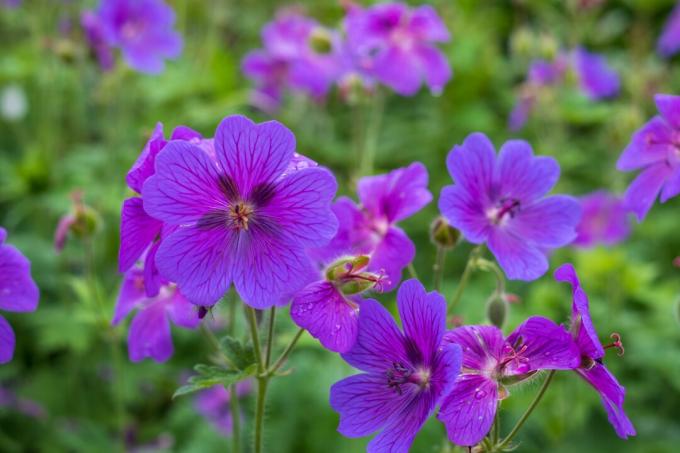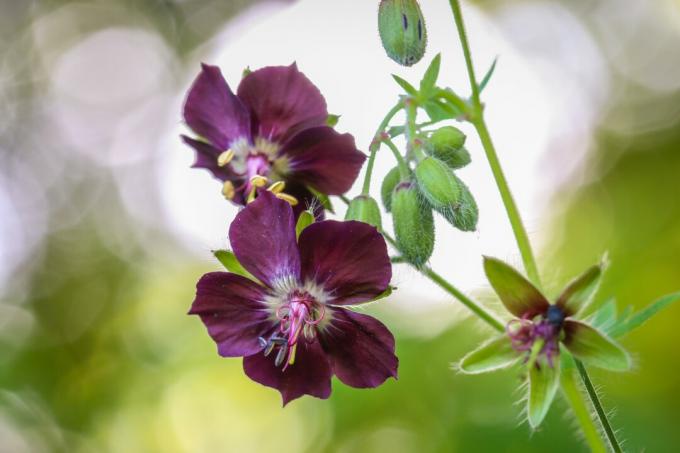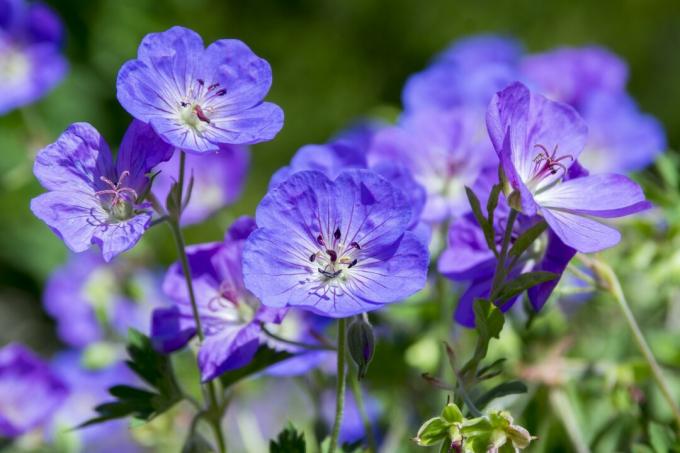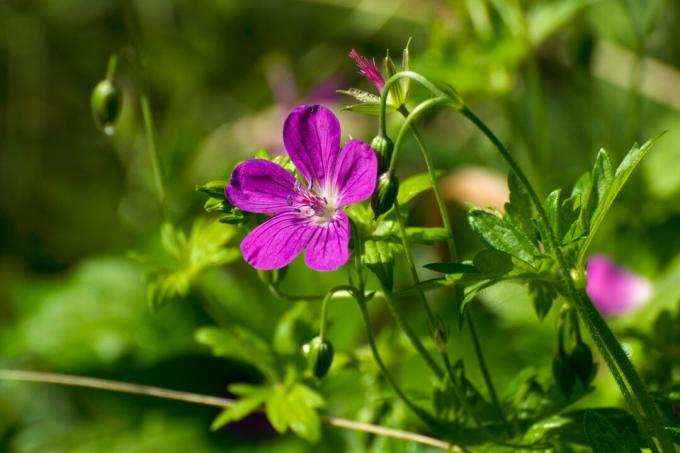There are a variety of cranesbills that are suitable for a wide variety of locations. We present the most beautiful geranium species and varieties.

Of the Cranesbill (Geranium) is a popular garden plant for perennial beds and plant troughs on patios and balconies. We give an overview of the great variety GeraniumSpecies and varieties.
contents
- Cranesbill Species: How Many Are There?
-
An overview of the most beautiful types and varieties of the cranesbill
- Armenian cranesbill (Geranium psilostemon)
- Blood-red cranesbill (Geranium sanguineum)
- Brown cranesbill (Geranium phaeum)
- Rock cranesbill (Geranium macrorrhizum)
- Gray cranesbill (Geranium cinereum)
- Caucasian cranesbill (Geranium renardii)
- Little cranesbill (Geranium pusillum)
- Magnificent cranesbill (Geranium ibericum x platypetalum)
- Pyrenean cranesbill (Geranium pyrenaicum)
- Smelly cranesbill (Geranium robertianum)
- Marsh cranesbill (Geranium palustre)
- Forest cranesbill (Geranium sylvaticum)
- Soft cranesbill (Geranium molle)
- Meadow cranesbill (Geranium pratense)
Cranesbill Species: How Many Are There?
The genus of the cranesbills comprises more than 300 species that are distributed worldwide. Some species grow upright, others overhanging, creeping or cushion-like. Among the diverse growth forms, there is guaranteed to be a suitable species for every garden. After all, the cranesbill also feels at home in various habitats: from lime-loving mountain species to bog dwellers, cranesbills are extremely adaptable.
An overview of the most beautiful types and varieties of the cranesbill
Among the numerous cranesbill species that are available at nurseries and in stores, there are major differences in growth form, flower color and location requirements. In our overview you can find out more about the most beautiful cranesbill varieties and species.
Armenian cranesbill (Geranium psilostemon)
The Armenian cranesbill grows upright and can grow to between 80 and 100 cm. The perennial shrub prefers fresh to moist soils in sunny to partially shaded locations. The palmate, lobed leaves are deeply notched and serrated. The foliage turns bright red in autumn. The cranesbill is particularly splendid between June and July when it bears numerous, bright magenta-colored flowers with a dark center.
- ‘Ivan‘: Stable variety with a height of up to 70 cm and a long flowering period from June to August. The flower color is between pink and light magenta.
- ‘Sumela‘: Compact selection of the Armenian cranesbill with a height of 60 - 70 cm. The flowering period extends from June to July. A second flowering in September is possible with early pruning.

Crimson cranesbill (Geranium sanguineum)
The blood-red cranesbill, also known as the blood cranesbill, is a wild plant native to Central and Southern Europe. The 15 - 60 cm high plant can be found mainly on dry hedges and forest edges as well as in light deciduous forests in warm places. The hairy leaves of the blood cranesbill are rounded and divided almost to the middle. The comparatively large flowers sit individually on axillary pedicels and appear between June and August.
- 'Album': Cranesbill with pure white flower color. The perennials, up to 40 cm high, bloom between June and August. A bright yellow autumn color develops in autumn.
- ‘Apple blossom‘: Younger variety with white flowers, a pale pink tinge and somewhat darker veining. The filigree plants of this cranesbill variety reach heights of around 20-30 cm and bloom between June and August.
- ‘Max Frei‘: Cranesbill variety with hemispherical and compact growth up to 25 cm. Purple-pink flowers appear between June and August and the foliage becomes intense in autumn.
- ‘Tiny Monster‘: Vigorous, up to 40 cm high cranesbill variety with many small, purple-red flowers. The long flowering period of this low strain extends from June to September.

Brown cranesbill (Geranium phaeum)
The brown cranesbill comes from the Pyrenees, Carpathians and the Balkans. The up to 70 cm high, upright perennials grow in shady to partially shaded locations with fresh to dry soil. They are therefore ideally suited for planting difficult, shady and dry garden corners. Compared to other cranesbill species, the brown cranesbill flowers very early, as early as May. It is named after the delicate, brown-purple to dark red flowers. Meanwhile, however, there are also varieties like ‘Album‘ that bloom in white. The species reproduces by self-sowing and quickly grows wild in the garden.

Rock cranesbill (Geranium macrorrhizum)
The rock cranesbill, also known as the Balkan cranesbill, comes from the mountain regions of the Alps as well as the Carpathians and the Balkans. The rhizome-forming, mat-like growing cranesbill species is about 20 - 30 cm high. The round, lobed, grass-green foliage shows a red-yellow autumn color from September. Several white to red colored flowers with remarkably long stamens sit on reddish stems between May and July.
- ‘Spessart‘: White cranesbill with pink calyx. The variety becomes about 25 - 35 cm high and flowers from May to July.
- ‘Czakor‘: Balkan cranesbill selection with red to pink flowers. The 30-40 cm high perennials bloom between May and July.

Gray cranesbill (Geranium cinereum)
The gray or ash gray cranesbill originally comes from the Pyrenees and grows prostrate to upright. The adaptable species thrives on fresh to dry, sunny soils and is therefore also suitable for planting steppe beds or rock gardens. The round, strongly lobed and gray-green leaves give this cranesbill species its name. Cup-shaped, white to light pink and darkly veined flowers appear between June and September.
- 'Ballerina': Cranesbill with a height of 15-20 cm and pale pink flowers with strong, dark veins. The variety blooms from June to September and is particularly suitable for dry soils.
- ‘Jolly Jewel Salmon‘: Special salmon red flower color and dark eye. This evergreen cranesbill variety remains very small at 10 - 15 cm and is therefore suitable as a ground cover and for planting natural stone walls.
- ‘Purple Pillow‘: Visually very attractive geranium variety with gray foliage and cup-shaped, dark purple flowers with dark veins. The flowering time of the ground cover cranesbill, which is up to 20 cm high, extends from June to September. The leaves turn orange-red in autumn.

Caucasus cranesbill (Geranium renardii)
The Caucasus cranesbill loves dry and sunny locations, and also likes stony and lime-rich. It forms pillow-like cushions and is only 20-25 cm high. In rock gardens and on barren, stony soils, this cranesbill is very popular as a ground cover. The kidney-shaped leaves are gray-green and hairy, coarsely lobed. The approximately 2.5 cm wide, white, darkly veined flowers appear between June and July. The Caucasian cranesbill often spreads by self-sowing.

Little cranesbill (Geranium pusillum)
The little cranesbill, also known as the dwarf cranesbill, is a native, wild cranesbill species. The 15 - 30 cm high, one to two year old plants thrive in fields, fallow land, rubble and gravel areas as well as on roadsides and even in cracks in the pavement. The lesser cranesbill is considered a pointer plant for nitrogen in the soil. The rounded leaves of this species are slightly notched. The tiny, pale pink, purple or purple flowers appear between May and October.

Magnificent cranesbill (Geranium ibericum x platypetalum)
The magnificent cranesbill is a hybrid species and grows particularly dense and bushy to a height of 60 cm. The perennial perennial thrives on fresh, warm and calcareous soils in a sunny to partially shaded location. The round, lobed, downy leaves of the magnificent cranesbill turn orange-yellow in autumn. The 4 - 5 cm large, five-fold flowers appear from June to July and shine in blue-violet hues. The sterile hybrid species only partially forms fruits with non-ripening seeds; instead, it spreads via runners in the bed.
- ‘Rosemoor‘: Cranesbill with compact and steadfast growth up to 60 cm. Blue-violet flowers with dark veins appear between June and July. Extremely adaptable variety with distinction in the perennial sighting.
- ‘Rozanne‘: Cranesbill hybrid with strong growth. It can be raised lying down or climbing, as it develops shoots up to 150 cm long. The blue-violet flowers with a white center appear between June and November.

Pyrenean cranesbill (Geranium pyrenaicum)
The Pyrenean or Basque cranesbill is widespread in almost all of Europe and grows preferentially on roadsides and wild hedges. It grows to a height of 20 - 60 cm and forms round flowers in pairs with deeply edged, purple-red petals.

Smelly cranesbill (Geranium robertianum)
The stinking cranesbill is a native wild plant that is widespread in our country and is also known as the common cranesbill or Ruprecht's herb. The 15 - 40 cm high, biennial plant grows preferentially in damp, stony to rocky and shady locations. When touched, it gives off an odor that is unpleasant for many. The leaves are three-fingered and roughly lobed. Between June and September, the pink-striped, small flowers of the cranesbill appear on reddish-colored stems. The seeds ripen in the course of autumn and are catapulted several meters out of the suddenly opening split fruit. The Ruprecht cranesbill is still important today in herbal medicine and natural cosmetics.

Marsh cranesbill (Geranium palustre)
The swamp cranesbill, native to moors and floodplains in Europe, reaches a height of 30 - 80 cm. The leaves are five to seven parts, as well as irregularly cut or serrated. The paired flowers are 3 - 4 cm in size and bloom between June and September. The swamp cranesbill is ideal for planting pond edges, bank areas and wet meadows, as it can cope well with waterlogging.

Forest cranesbill (Geranium sylvaticum)
The forest cranesbill is mainly found in the Alps and in the low mountain range. The 20 - 60 cm high plant prefers moist mountain meadows, also in the shade of trees or tall shrubs. The irregularly shaped, rather broad and deeply incised leaves are densely covered with glandular hairs. The red-purple flowers of the forest cranesbill, which appear between June and August, usually sit in pairs at the end of a hairy flower stalk.

Soft cranesbill (Geranium molle)
The soft cranesbill is native to warm, permeable locations all over Europe and forms particularly dense, downy, soft hairs on stems and leaves. The plants reach a stature height of just 10 to a maximum of 40 cm and form small inflorescences. The pale pink flowers appear between May and September.

Meadow cranesbill (Geranium pratense)
The meadow cranesbill grows upright up to 80 cm and is dependent on open areas with deep, humus and sandy-loamy soil. The palmate notched leaves take on an attractive autumn color from September. The originally pale blue, mauve colored flowers appear between June and July. With the meadow cranesbill, breeding has succeeded in not only selecting other flower colors, but also double and half-double flowers.

- ‘Double Jewel‘: Cranesbill variety with a double flower envelope in creamy white with a purple eye in the middle. The plants reach heights of up to 40 cm and bloom from June to August.
- ‘Laura‘: Double meadow cranesbill with pure white flowers. The 60 cm high perennials bloom between June and August.
- ‘Midnight Rider‘: Up to 50 cm high cranesbill with purple-blue flowers between May and July. The dark brown to bronze colored leaves are rich in contrast and are suitable as an ornament.
- ‘Summer Skies‘: Cranesbill with pale purple to pink, double flowers. The variety reaches a height of 60 cm and flowers between June and August.
After choosing the right variety, that's what it's about Planting and caring for cranesbill. We give important tips on planting time, care measures and propagation.
